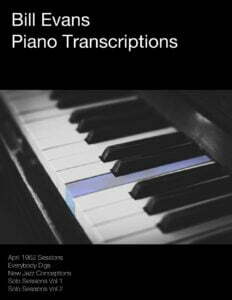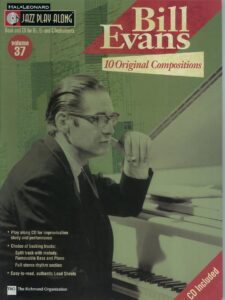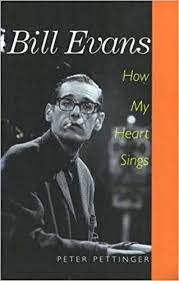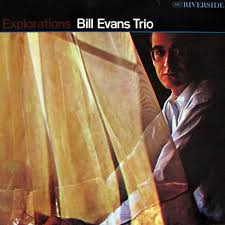Come join us now, and enjoy playing your beloved music and browse through great scores of every level and styles!
Can’t find the songbook you’re looking for? Please, email us at: sheetmusiclibrarypdf@gmail.com We’d like to help you!
Table of Contents
Remembering The Rain – Jazz Standard by Bill Evans (Piano Solo sheet music, Noten, partition)

Please, subscribe to our Library.
If you are already a subscriber, please, check our NEW SCORES’ page every month for new sheet music. THANK YOU!
Best Sheet Music download from our Library.
Bill Evans, a genius of jazz who was killed by the drug
This September 15, will be forty-three years of the death of some of the most influential artists in jazz, Bill Evans (1921-1980), pianist and composer of aesthetics, calm, heavily influenced by the classics, he claimed from his instrument the value of the space and the silence.
Bill Evans died in New York at 51 years old , due to complications of a hemorrhage caused by a stomach ulcer-associated hepatitis with a box of pneumonia and malnutrition; had arrived accompanied by his drummer Joe LaBarbera and his girlfriend Laurie Verchomin to the hospital Mount Sinai to be seen, and where he died on the same day that you entered. He suffered a long heroin addiction , which left him with a methadone treatment, and who ended up replacing it, to the mid-seventies, by the cocaine. “It was the suicide throughout history,” said Gene Lees, a music critic and friend of the pianist.

Bill Evans was a musician, prolific, that gave the jazz their deep knowledge of the classics, especially the French impressionists, creating a creative communion stylistic opened one of the roads more interesting and innovative in the genre.
An artist of a huge influence on his colleagues; a survey in 1984 revealed that only the great Art Tatum was over Evans as the pianist more influential in the history of jazz . His appearance dressed up, college student, with glasses of carey and combed back and hid until a certain point, your drama, a strong addiction to heroin that caused him to physical problems and a chronic break economic that drove him to live borrowing money to friends and people in the environment to become a common place in your life.
Bill Evans became known through his invaluable contribution to the music of Kind Of Blue (1959) in the wonderful sextet with trumpeter Miles Davis (1926-1991). Evans was the great contrast of the lit musical statements of saxophonists John Coltrane and Cannonbal Adderley , aesthetics, calm, reflective, transmitted to him the intimate nature that is imposed on the disk and an emotionality that is uncommon in the work of jazz up until that time (maybe, but only maybe, we could talk about the music of Ahmad Jamal); Blue in Green or Flamenco Sketches to show to what extent was influenced by the pianist in the atmosphere of the album.
Evans was only eight months in the group of Davis . “I felt exhausted in every way, physically, mentally and spiritually”. She had entered the band in May 1958 and abandoned in November to accompany the last days of life of his father, in Florida, to return in January 1959, at the request of Davis recording Kind Of Blue.
During the sessions of this album, the story has it that Davis one afternoon, we went to Evans a sheet of paper with two chords, and asked What would you do with this? That night, in his room, the pianist wrote Blue in Green , who ended up signing Davis. When Evans clarified that they should be sharing the royalties of that topic, the trumpet player, he was offered a $ 25 check . Evans, in addition, he wrote the notes of the album in which associated the improvisation of jazz the art visual japanese.
Evans developed a new concept of the piano trio (with double bass and drums), the training is more usual modern jazz, and that, precisely, this evolution constitutes good part of the legacy of the pianist.
Suggested greater interaction between the instruments to such an extent that it ended up becoming a conversation in which there is a leader. Managed to capture this challenge almost at the beginning of his career, when he put together an amazing combo with the bassist Scott La Faro (1936-1961) and Paul Motian (1931-2011) on drums, with whom he recorded an album that is brimming with history, Sunday at the Village Vanguard , the sessions recorded on June 25, 1961 at the club, with an ambient sound that gave him a unique atmosphere to the album.

Remarkable, outstanding, cutting-edge, could be the definitions of this work that brought together 21 topics vital to the occurrences of the genus.
Before entering the group of Davis and consecrate himself with his trio for his performances in the Vanguard, Evans already had a solid experience.
He participated in the legendary album Concerto for Billy The Kid (1956), directed by the composer George Russell and had recorded their first album, New Jazz Conceptions (1956), with Teddy Kotick and Paul Motian, where he premiered his famous Waltz for Debby (dedicated to his niece), and Five and even though he had excellent reviews, even won the poll of critics from the drop down-beat notes as Best Pianist in Revelation, went virtually unnoticed by the public and only sold 800 copies; in addition to had been playing with Chet Baker, Charles Mingus, Art Farmer, and Oliver Nelson , among others.
But back to the trio. Without a doubt, the top managed Evans is also due to the quality of The Lighthouse and Motian, especially of the double bass player, a musician, a virtuoso amazing that I knew to build a network of counter-melodies from talking with the piano, his style sometimes almost guitar in the instrument and a sense of free time generating cool air inside the group, always protected by the subtleties of Motian on drums.
A combo with a rhythmic energy and a touch more implied than expressed, opened a creative way. “We tend to conceive of jazz as a style, but I think that is more of a process for making music, the process of doing a minute of music in a minute of time, whereas when it is composed classical music, a single minute could take three months . This is a fundamental difference, when Chopin, Bach or Mozart improvised music, when they were making music at the moment, they were in essence playing jazz.
We spoke in absolute sense with our moods, and the musical art is the art of talking with the quality of spontaneity. This is the most exciting part of jazz,” he said in an interview.
Eleven days after the sessions in the Vanguard, July 6, 1961, in a traffic accident, dies LaFaro, was 25 years old. For the pianist, who was a total artistic communication with the bassist, was a devastating blow; he disappeared for months of the scene while his addiction to heroin, which would have begun in the mid-fifties, was deepened .
In those collective of New York said that was the talented drummer Philly Joe Jones, addicted historic in the world of jazz, who would have started. Beyond this, the sudden death of the Lighthouse affect him and would not be the last, since at least you were waiting for the other two, the suicide of his former partner Ellaine Schultz (addicted to heroin) and his brother, Harry.
Evans returned a few months later, the scenarios and while the new concept of the piano trio was strong enough to withstand changes of staff, presented unusual demands for musicians, hence the care that you put the piano in the elections of their companions.
Rearms his trio with different formations, in which usually the bass player was Chuck Israels; he recorded even with the recently deceased Gary Peacock (1935-2020) and Paul Motian, in “Trio 64” until recently in 1966 able to settle with a trio that is felt at ease; they were the bass player from puerto Eddie Gomez (with which he was eleven years old) and Marty Morell on drums.
Especially, Gomez brought innovation to the music through a fast and creative rhythmic grooves and slight tone gave a sound of guitar deep. Works such as Bill Evans at The Montreux Jazz Festiva l (with Jack Dejohnette on drums) (1968), Quit Now (1969), Evans in England (1969) and Live in Paris (1972) let in evidence a high level of interaction between the pianist and Gomez. Get real dialogue without a dominant presence.
Launched 82 discs, 33, in vivo. Albums notable as Sunday at the Village Vanguard (1961), Portrait in Jazz (1960), Undercurrent (1962), in duo with the guitarist Jim Hall, Conversations with Myself (1963), Alone (1968), Some Other Time (1968), Bill Evans at The Montreux Jazz Festival (1968), What’s New (1969), The Bill Evans Album (1971), Live in Paris (1972), But Beautiful (1974) with Stan Getz on tenor sax, New Conversations (1978), We Will Meet Again (1979) and The Final Village Vanguard Recording (1980).
Received 31 Grammy nominations, seven awards, and was recognized in 1994 with the Grammy Lifetime Achievement Award.
A violent home
William John Evans was born in North Plainfield, New Jersey, August 16, 1929, the son of Harold Evans and Mary Soroka. A father ludópata, with problems of alcohol abuse and violent created a tomentose climate in the home that meant that Mary and their two children could take refuge there in the house of his sister, Justine, in Sommerville, where they began to take piano lessons with Helen Leland, Harry, seven, and Bill, with five.

The pianist remembered it with fondness for its unorthodox form of teaching, which is crucial to love the instrument. Paradoxically, Leland considered Harry as a true talent in front of Bill, on the other hand the little time he began to study violin, and flute. Evans had influences of Debussy, Ravel and Chopin, but also studied in depth the Suite Provençale by Darius Milhaud as the music composed by Igor Stravinsky for the ballet Petruschka .
Immersed as he was in the great masterpieces, was surprised at the age of twelve by the big bands of Tommy Dorsey and Harry James sounded again and again on the radio. Already as a teenager, he started in small groups, in which charged a dollar per night, it was in one of these presentations that dared to change chord on the topic Tuxedo Junction , and lived that feeling of stepping out of the libretto, the music written, what was to become the first memory of his initiation into the jazz.
He graduated from the bachelor of Music at Southeastern Louisiana College; his companions remembered as a young, shy, excellent athlete and very dedicated to the study of harmony. The pianist recalled his last three years in college as the happiest of his life.
In 1950, he made a tour of three months with the band’s bassist Red Mitchell accompanying Billie Holiday , tour that ended at the Apollo Theater, Harlem, New York city.
Evans spent three painful years spent in the army (1951-1953), which coincided with a time that is emotionally difficult, as their whole moderna look of harmony was widely criticized by their peers. Perhaps his biggest problem was the lack of confidence in himself at that time; instead of feeling misunderstood, that he was, he believed he had to study and talent. In July, 1955, traveling from Florida, the house of their fathers, to New York, where it installs and starts a real climbing vertically as an artist. The crisis of confidence were recurrent in all these years that was closed upon himself to study and to continue making progress, although his artistic environment no longer needed evidence of his talent.
During your stay in Southeastern Louisiana, in the second part of the forties, he began to consume soft drugs such as marijuana and already in New York, along with Elliane Schultz, who would become his partner for more than ten years, he began to consume heroin, drug key in the atmosphere of the jazz of the ’50s. While its recognition was spreading, and growing your addiction .
Cuts in the supply of electricity, gas and moving rushed for non-payment were standing in the ’60s. Always economically broken and painful signs of his addiction showed no serious desire to stop using . Anyway, I had an iron discipline in regard to his music; in the mid-sixties, while injected touched a nerve that left him paralyzed temporarily, his right arm, away to cancel the week of presentations that I had in the Vanguard he played all those nights with a single hand.
At the beginning of the seventies, stopped next to Elliane at Kennedy airport, New York, with heroin, and he is forced to enter for not going to jail in a methadone treatment. Both are kept clean for a long time, by which time Evans enjoyed a certain emotional peace that allowed him to compose and go moving forward economically.
In 1973, Bill Evans met Nenette Zazzara in California, and despite the loving relationship that he had with Elliane, he left her to marry Nenette. Apparently, the desire to have a child on the part of Evans and the infertility of Elliane could have been a trigger in this separation; married with Nenette , in 1975, they had a son, Evan, and while his previous companion seemed to understand it, after some little time she committed suicide by throwing herself to the underground.
Another hard blow to her fragile stability; the couple lived years down until gradually returned to his addiction to drugs, which determined that Nenette abandon taking Evan. The last time Evans left in evidence throughout his career as a self-destructive; after returning to treatment with methadone began to consume cocaine.
This picture by itself is troubling joined the suicide of her beloved brother Harry – Diagnosed with schizophrenia, shot himself on June 20, 1979. This perhaps was the final push that you need Evans to finish fall. His sister-in-law Pat Evans has stated that she knew Bill would not last long after the death of his brother and his girlfriend Laurie Verchomin noted, “then voluntarily abandon their treatment of hepatitis, Bill, it was clear that he would die in a short time.”
Bill Evans was one of the major innovators who had the jazz, his talent was not only focused on his extraordinary harmonic language, he was a great improviser who based their message on the grounds melodic or rhythmic of an unusual emotional depth. “My key to improvise is that my hands do not go faster than my mind” , said Evans. With the passage of time, became a school for pianists and a state of mind to listeners.
In his library he had works of philosophy, psychology, and humor, Plato, Voltaire, Freud, Sartre, and essays on hinduism, islam, buddhism, zen. Apparently, it was Evans who introduced John Coltrane when played with Davis in the indian philosophy of Krishnamurti. He was also sarcastic and intelligent fun. During a dinner after having played in a club was featured in the table that a producer from new york, with the worst attitudes, had committed suicide. Evans said simply: “he Was killed in self-defense.”
Bill Evans was buried next to his brother, Harry, in the Roselawn Memorial Park in Baton Rouge, Louisiana.
